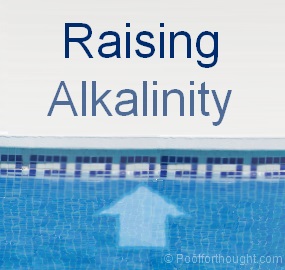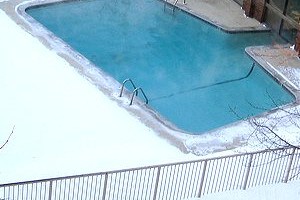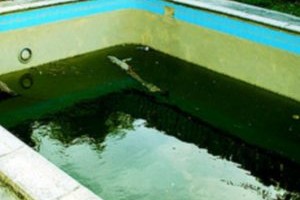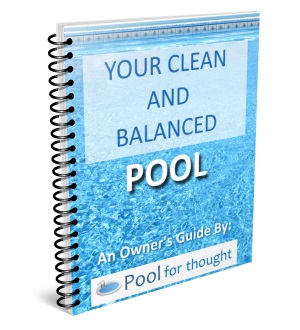
In this article, I explain raising pool alkalinity. Specifically, how to raise the total alkalinity of your swimming pool water. If you would like an overview of total alkalinity and why it is important for your swimming pool, read Maintaining Swimming Pool Alkalinity. If you would like the know how to test the alkalinity of your pool, then check out: Testing Swimming Pool Alkalinity. If you know your alkalinity is high, then read Lowering Swimming Pool Alkalinity.
Importance for your pool
Why raise the pool water alkalinity level?
One of the biggest reasons to keep your alkalinity level balanced is low pool water alkalinity can be damaging to your pool. Pool walls and surfaces can be etched, pitted, cracked, and delaminated. Metals surfaces can discolor, corrode, then finally dissolve. This can result in stained pool walls. With low alkalinity, the water pH is no longer stable, and minor changes in the pool chemistry can cause large fluctuations in pH, often called pH bounce.
Not only will you have trouble with damaged pool surfaces and equipment, but any chlorine added to the pool is less effective. The result is you have to add much more chlorine to achieve the same sanitizing effect. This adds expense and takes more time to keep the chlorine level at the desired concentration.
Swimmers will also complain, as water that is low in alkalinity will also often bring the pH level down in the water. The resulting water is acidic, which can sting eyes, nasal passages, and skin.
I discuss all the individual ways low pool alkalinity can cause trouble in the article: Maintaining Swimming Pool Alkalinity.
Why is my total alkalinity level too low?
- You may have lowered the alkalinity too much using an alkalinity reducer such as muriatic acid or dry acid. If this is the case, you need to add only a portion of the recommended dosage when lowing your alkalinity, then retest about six hours later.
- You may have backwashed or otherwise drained part or all of the pool water. If you add water to your pool, and the water source has low alkalinity, then this will decrease the overall total alkalinity of your pool. How much the alkalinity decreases depends on how much water you add, how large your pool is, and the water source alkalinity.
- It also may have rained, flooded, or some of the spring snow thaw may have seeped into the pool. Just as a local water source with low alkalinity would lower the total alkalinity of your pool, any other water with low alkalinity will do the same.
How to Raise Swimming Pool Alkalinity
Make sure to know how large your pool is, and how what your target range is. You ideally want to be in the middle of the range. 80-120 ppm (parts-per-million). Some pool contractors will recommend you stay between 100 – 120 ppm. Always follow their advice as the alkalinity requirements in your area might be slightly different.
Increasing alkalinity with Baking Soda (Sodium Bicarbonate)
In the pool industry, pool products intended to raise the alkalinity will have names like alka-buffer, alka-plus, alkalinity increaser, and similar names. Just make sure the product is made from sodium bicarbonate before you purchase. Sodium bicarb, or baking soda, is the key substance used to raise alkalinity. It is cheap and readily available, so there really is no need to use anything else.
The baking soda you can buy from your pool supplier is the same as what you can buy from a retail store. The big difference is on the labeling. Retail store baking soda is not labeled for use in pools, and has no directions on how much to add to your pool. For this reason I recommend buying from your pool supplier. You can buy baking soda in bulk from your pool supplier, and in the larger quantities they should be cheaper overall anyway.
Increasing Alkalinity Step-by-Step
- Test total alkalinity. First test your pool water total alkalinity level, as you need to determine how low your alkalinity may be, and by how much. If your level is low (less than 80 ppm), then you need to raise the pool water alkalinity.
- Be sure to buy enough. Purchase a container of sodium bicarbonate. Talk to the retailer to make sure you purchase enough. If you buy a small 5-pound container, you often will need much more than this if your alkalinity is very low.
- Know how much to add. Determine how baking soda should be added to the pool water. Unless you are comfortable adding chemicals, only add one-half or three-fourths of the amount recommended. You can always add more later if the level is still low. This is to avoid adding too much and end up having to lower the pool alkalinity.
- Dilute if necessary. The instructions might say to dilute. Follow the product instructions for dilution if this is the case.
- Add to the pool. Sodium bicarbonate usually is packaged in powder form. It is safe to add to the pool this way, but try to avoid doing this in the wind as it can be carried by the air. Spread the amount of sodium bicarbonate into the pool. Pour in light, arcing motions to prevent too much entering the water in one place. Baking soda dissolves quickly in water, so you should see the substance disappear in a few minutes.
- Let the pool sit. Wait at least six hours before retesting, but try to wait no longer than 24 hours.
- Retest alkalinity and repeat if needed.If you find your total alkalinity still low, then you will need to go through the steps again.
Tips on raising swimming pool alkalinity
- You need to rely on the product label to determine how much to add, based on the ppm you want to raise and the size of your pool. Some manufacturers will recommend adding differing amounts, suggest only adding a certain amount at a time, and some will suggest to first dilute the baking soda in water before adding to the pool.
- The type of pool you have also matters in terms of the ppm range you need to adhere to, but if you maintain a 100-120 ppm range, this will be sufficient for concrete, vinyl, fiberglass, gunite, or shotcrete pools.
- After months and years of testing, you may notice patterns in your alkalinity, such as adding water tends to raise or lower alkalinity. You may want to adjust the amount of alkalinity increaser based on this knowledge.
Conclusion
Keeping your swimming pool alkalinity level balanced is important to keeping your overall water balanced. Avoid low alkalinity in your pool by testing occasionally and promptly raising the level to prevent damage to your pool surfaces and equipment, plus avoid extra chemical expenses.
Pool For Thought Pool Store
Here are all the items discussed in this article to raise swimming pool alkalinity and keep your swimming pool balanced all season:
![]()
Source:
- “Pool & Spa Water Chemistry, A Testing and Treatment Guide, Waterproof Edition, 2005. Taylor”





